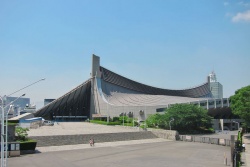Yoyogi National Gymnasium
| Yoyogi National Gymnasium | |
|---|---|
| Yoyogi | |

| |
| Location | 2-1, Jinnan, Shibuya, Tokyo, Japan |
| Broke ground | February 1963 |
| Opened | October 1964 |
| Owner | Japan Sport Council |
| Architect | Kenzo Tange |
| Tenants | none |
| Capacity | 13,291 (1st Gymnasium) 3,202 (2nd Gymnasium) |
Yoyogi National Gymnasium (国立代々木競技場) is an arena located in Yoyogi Park, Tokyo, Japan which is famous for its suspension roof design.
It was designed by Kenzo Tange and built between 1961 and 1964 to house swimming and diving events in the 1964 Summer Olympics. A separate annex was used for the basketball competition at those same games. It will also host handball competitions at the 2020 Summer Olympics. The design inspired Frei Otto's arena designs for the Olympic Stadium in Munich.
The arena holds 13,291 people (9,079 stand seats, 4,124 arena seats and 88 "royal box" seats) and is now primarily used for ice hockey, futsal and basketball. Images of the arena are regularly featured at the end of NHK Newsline broadcasts because the NHK World studios are adjacent to the arena along the edge of Yoyogi Park.
In October 1997 the National Hockey League opened its season at the arena with Vancouver Canucks vs Mighty Ducks of Anaheim in two matches. The following season San Jose Sharks played Calgary Flames in two games to open the 1998–99 NHL season.
| This page uses Creative Commons Licensed content from Wikipedia (view authors). |